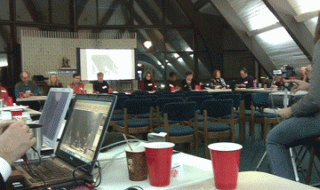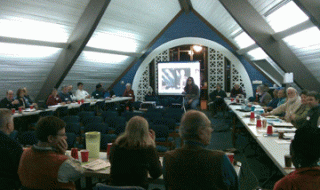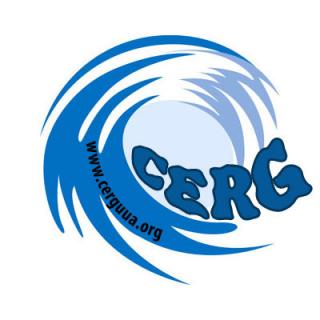CER History
How the Central East Region Came to Be
The opportunities for our faith are breathtaking. We must prepare to minister to the multicultural America that we are living into or risk disappearing as a part of the religious landscape. Together, we can be the religion for our time.
–Peter Morales, UUA President

First meeting of district representatives in 2010.
As the leadership of the Central East Region (CER) of the Unitarian Universalist Association changes, as new leaders come on and experienced ones retire, it's important to record the beginnings of regional cooperation and partnership. Here is the story of the first years of our venture, the start of the sharing of resources and talent among the four historical districts of the UUA that make up the Central East Region.
The Central East Region stretches from the Canadian border of New York State to the metropolitan DC area which includes northern Virginia, from the Atlantic Ocean to western Ohio. Within the region there are about 200 UU congregations. With some 34,750 members, we are the largest region in the UUA.
The CER districts were the Joseph Priestley District, the Metropolitan New York District, the Ohio Meadville District, and the St. Lawrence District. They were four among the orginal twenty-one districts of the UUA.
Beginnings
Before there was CER, there was NRG, the New Regional Group. This was simply a cooperative venture among district and UUA staff. They would consult with each other and plan some collaborative programs, such as leadership development with UULTI, the UU Leadership Training Institute, and conflict management. For a time, during a transition in district staff, a single District Executive led both SLD and OMD, so cooperation was perhaps further enhanced.
On April 4-5, 2006, the District Staff from JPD, MNY, OMD, and SLD met at Murray Grove Retreat Center to see if there might be new and improved ways to deliver services to our congregations based upon a four district regional model. It was assumed from the beginning that in this model that each district would maintain its own autonomy. It was also understood that each district would have a DE responsible for building the individual districts but that the services of the DEs and Program Consultants and other district based staff would be shared among the four districts based upon skills and talents.
Formation of an Intentional Regional Group
For District Presidents, the November 2009 meeting of the District Presidents Association was very significant. The UUA Moderator and the newly-elected UUA President challenged the Presidents to think in new ways. Many districts were using Policy-based Governance, and the UUA nationally had just adopted it. Did it make sense to have two different PG Boards direct the work of the District Executives? How should the DEs react to performance monitoring from two governing bodies? How much duplication was there in finding 19 different priorities and techniques to serve the UUA's congregations across the country? Might an organization of five regions be simpler?
With these questions in mind, the four District Presidents and the four District Executives of these regions met in Boston in December 2009. The UUA's then Director of Congregational Life, Harlan Limpert, participated as well. The agreement that emerged was to form a cooperative program among the four districts, to name it CERG, or Central East Regional Group, and to work together on programs and operations that focused on the potential for growth in the region. Later this name was changed to the Central East Region or CER.
Planning
A group of three District Executives, one District President, and two UUA staff worked together to work the December agreement into a planning document. They worked for several months, with frequent conference calls and shared documents. A draft plan emerged.
The plan had these characteristics. The District Executives would remain in place, with each one continuing a major role in serving congregations at the district level. But there would be three full-time and specialized regional consultants, replacing the district-level program consultants. Their specialties would be 1) lifespan faith development, 2) growth, and 3) leadership development. The UUA would pay 25% of their salaries; the districts would share remaining costs on a per capita basis. In addition, there would also be a quarter-time consultant for communications and IT support serving the whole region. The regional plan established a program to select and promote "threshold congregations," a group of congregations that could grow if they could get some advice and extra resources from the regional consultants or others, a group that would develop and follow their own growth plans and then serve as mentors for other congregations to grow as well.
The plan did not include any changes in governance. The emphasis was on operational cooperation and mutual support. Governance changes would develop and evolve over time.
Approval of CER Proposal

First meeting of district representatives in 2010.
At a large meeting in Harrrisburg, PA, in March 2010, attended by most of the members of the four district boards, the four DEs (Tom Chulak, Andrea Lerner, Richard Speck and Joan VanBeceleare), and UUA staff involved in the plan along with Harlan Limpert, the four boards talked about the CER proposal and worked out some details. Annette Marquis, the DE of the Southeast District, facilitated our two-day meeting. All four district boards approved the plan with minor changes, and subsequently all four boards or district assemblies (depending on governance structure) approved their districts entering into the partnership with the other districts and the region. The final version of the plan was produced, and the CER website was launched.
Implementation of Plan

Early logo of the Central East Region.
At a meeting at the 2010 General Assembly in Minneapolis, the four district presidents and four district executives agreed to regular (weekly) conference calls over the summer and fall. We talked about the hiring of the three regional consultants. We determined the criteria for selection as a Threshold Congregation and we assembled the application form and material requested from congregations. This planning continued into the fall, along with continuous coordination with the UUA. The DEs came to agreement on the procedures for sharing costs of the regional consultants.
By the fall of 2010 the three regional consultants were all in place: Mark Bernstein as Growth Development Consultant, Patricia Infante as Faith Development Consultant and Renee Ruchotzke as Leadership Development Consultant. Also by the fall, the invitation to apply as a Threshold Congregation went to all congregations in the region. In January 2011, the first group of nine Threshold Congregations were selected. By the spring or early summer of 2011 work had begun between the congregations and the regional consultants.
Monitoring by Four Boards
In May 2011, representatives of the four Boards again met in Harrisburg. Laura Park of Unity Consulting facilitated the meeting. There was a review of what had been done so far as a region, and a wide-ranging discussion of next steps. Of particular importance was a greater understanding of the resources available on the Web for congregations and individuals to use—webinars and tutorials and a wide range of other items. The four boards agreed to continue the collaboration and agreed further to meet again in the spring of 2012.
Brandeis University, which is responsible for an evaluation of a similar UUA program called Leap of Faith, was contracted to prepare an evaluation of the Threshold Congregation program.
Continuation
In the early months of 2012, a second set of nine congregations became our second class of Threshold Congregations. The four district executives, four district presidents, one other district Board representative from each district, and UUA Director of Congregational Life Terasa Cooley met in Binghamton, NY, again for a check-in and to plan the next meeting of the full Boards.
Since 2012, the four boards have come to the realization that more needed to be done. Staff needed access to UUA resources and connections. Many things would be more efficient if combined into one entity instead of four. A "transitions team" of representatives of each district was created to determine the best ways to move forward. Their work resulted in the Memorandum of Understanding (PDF) which launched the work of "regionalizing."
In the spring of 2016 the four districts voted to regionalize with more than 90% of the vote in each case. Three districts voted to dissolve immediately and the Joseph Priestley District dissolved in the spring of 2019 after some additional requests were met. CER staff are now fully employed by the UUA, CER finances are successfully merged with the UUA and CER is working well with the other four regions to advance the work of Unitarian Universalism by supporting our congregations.

